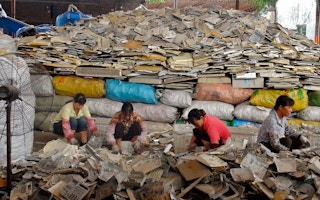The Covid-19 pandemic has resulted in far-reaching economic and social implications. Developing nations, where the crisis has overwhelmed vulnerable healthcare systems and exacerbated both poverty and inequality, have been hit the hardest.
Calls for a green recovery from the economic downturn have prompted the World Economic Forum to propose The Great Reset at Davos 2021, a set of initiatives to lay the foundation for a more sustainable and resilient world. In the Asia Pacific region, a key thrust of this transformation needs to be the accelerated adoption of comprehensive circular economy principles.
The reasons for that are obvious: On the production side, the region is a vital driver of global manufacturing and deeply integrated in global supply chains, with many countries being key suppliers of raw materials and producers of consumer and capital goods. Consumption, already high, is expected to rise exponentially with more than 3.5 billion Asians expected to be members of the middle class by 2030.
A circular economy is an economic concept that champions material recovery at the end of products’ lifecycle to channel resources back into production and eliminate waste. While circular business models have been widely adopted in European countries like Denmark, Finland, Belgium, and the Netherlands, the circular economy remains largely a buzzword in many parts of developing Asia.
Perhaps due to rising social pressure and investor emphasis on environmental, social and corporate governance issues, the term has been loosely used by both the public and private sectors to signal their social commitments to stakeholders.
However, Singapore-based consultancy AlphaBeta’s engagement with organisations across the region suggests that behind closed doors, there remains some resistance and questions around large-scale circular adoption.
Here are three immediate steps that governments across the region can take to facilitate the circular transformation.
1. Raise awareness
The first is to aggressively raise awareness of the benefits of a circular economy across government units, businesses, the public, and civil society. This requires comprehensive studies to be conducted to ascertain these benefits.
Indonesia is leading by example in this regard. The largest economy in Southeast Asia is pushing ahead with plans to develop a National Circular Economy Roadmap, and recently launched a study, led by Bappenas—the country’s development ministry—and the United Nations Development Programme (UNDP), to understand the potential impacts of a circular transition.
The results from this research lent weight to the many policy recommendations calling for a green economic recovery. For instance, the circular economy is net positive for the economy, and is estimated to add US$45 billion (over a business-as-usual scenario) to Indonesia’s GDP annually by 2030. Despite some degree of expected job losses in certain sectors, the transition will create 4.4 million net jobs for Indonesia, of which 75 per cent are likely to go to women.
As part of awareness-raising campaigns, it is also necessary to show businesses that there is a wide range of circular opportunities available to them—of which many are not technically prohibitive and could be easily accessed.
The use of local case studies will certainly provide inspiration by helping opportunities appear more familiar, relatable, and achievable. For instance, the Indonesian study cited CupKita, a start-up based in Jakarta that provides a reusable container service in an attempt to eliminate the use of single-use plastic cups. Another example is PT Sigin Interactive Indonesia which provides repair and refurbishing services for used electronics and home appliances, dead-on-arrival (DOA) products, and printed circuit boards.
2. Involve smaller businesses
Second, it is critical to get Micro, Small & Medium Enterprises (MSMEs) on board. In Southeast Asia, the vast majority of registered businesses (almost 90 per cent in some countries) are considered MSMEs—failure to involve them in the circular transition will lead to suboptimal adoption and benefits.
Although MSMEs may face barriers such as access to capital, they could be better placed than large enterprises to adopt circular economy practices. As businesses that succeed in a circular environment typically have operations that are adaptable to changing business environments, the smaller size and in-built flexibility of MSMEs could be an advantage. Large enterprises, on the other hand, often lack the nimbleness to retool their production systems and supply chains to adapt to a shift in their economic environment.
To support MSMEs in the circular transition, governments in the region could draw on lessons learned in other countries. For example, in the United Kingdom, the London Waste and Recycling Board (LWARB) created the Advance London programme to support local SMEs in exploring new circular economy markets, revenue streams, and business models.
Some countries in Southeast Asia have made good progress in this regard. In Vietnam, for instance, the Global Green Growth Institute created a handbook on green growth priorities, and also provided low-interest loans for SMEs with “green” projects.
3. Create conducive policies
The third step countries could take is to develop an enabling environment to promote innovative financing approaches to support the circular economy.
The Bappenas and UNDP study showed that a complete transition towards a circular economy in Indonesia requires substantial investment of around US$20 billion over the next decade. While the required investment could be partly funded by the savings that business could enjoy as they transition towards circularity, some larger-scale projects will require additional investors.
With over US$30 trillion in sustainable investment assets under management globally (and this is rapidly rising), there is no shortage of funds. But the onus is on developing Asian countries to enact the necessary capital market reforms to access these funding opportunities.
Indonesia is a good example of being proactive in this space, with the government passing legislation that led to the issuance of the world’s first sovereign green sukuk (a bond whose terms and structure are sharia-compliant), raising over a billion US dollars.
The Indonesian government further worked with the OECD to launch the Tri Hita Karana (THK) Roadmap for Blended Finance in 2018—a unifying international framework for mobilising additional commercial capital towards the Sustainable Development Goals (SDGs).
The Covid-19 pandemic has underlined the importance of improving resource security, prioritising environment conservation, and improving socioeconomic equity, especially across developing countries. It could be an opportunity for developing Asia to accelerate its shift to a circular economy and help build a more resilient economy, society, and environment.
With strong commitment, active participation, and strong collaboration between the public and private sectors, circular economy concepts could shift from being a buzzword to bringing concrete and tangible benefits in the years to come.
Bingxun Seng is a principal at AlphaBeta, a Singapore-based strategy advisory serving clients across Asia Pacific.
Mohak Mangal is an associate at AlphaBeta.























